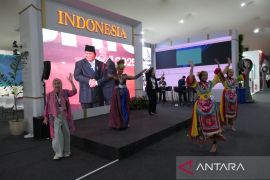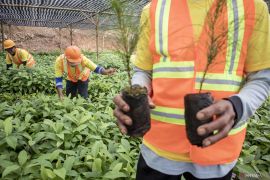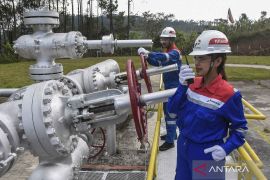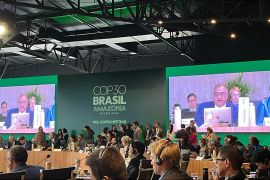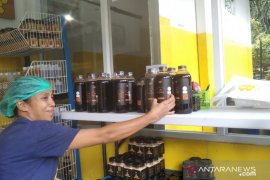Prolonged talks have been held between Indonesia and Norway to reduce greenhouse gas emissions. I remember it began in 2010, and Indonesia has kept its commitment to reduce GHG emissions by 26 percent by 2020 and 29 percent by 2030Jakarta (ANTARA) - President Joko Widodo (Jokowi) has jogged his aides’ memory on Indonesia's target to lower greenhouse gas emissions 26 percent below the business as usual level by 2020 through unilateral actions.
"Prolonged talks have been held between Indonesia and Norway to reduce greenhouse gas emissions. I remember it began in 2010, and Indonesia has kept its commitment to reduce GHG emissions by 26 percent by 2020 and 29 percent by 2030," Jokowi affirmed at the Merdeka Palace, Jakarta, on Monday.
Jokowi made the statement during a limited cabinet meeting on the Indonesia-Norway cooperation to reduce greenhouse gas emissions and carbon pricing, in which the attendees comprised cabinet ministers.
"Despite our current unwavering focus on efforts to handle the COVID-19 pandemic, there are some national strategic agenda on greenhouse gas emissions, including the cooperation between Indonesia and Norway, which should be sustained," he noted.
In accordance with the Paris Agreement adopted during the UN Climate Change Conference in Paris, also ratified by Indonesia, some sectors were included in the reduction of greenhouse gas emissions.
"We are obligated to reduce carbon emissions by 17.2 percent in the forestry sector, 11 percent in the field of energy, 0.32 percent in waste, 0.13 percent in agriculture, and 0.11 percent in industry and transportation," the president elaborated.
The head of state sought consistency in implementing the environment restoration program to reduce greenhouse emissions, ensure peatland protection, accelerate land and forest rehabilitation, ensure biodiversity protection and habitat recovery, and to support the development of biodiesel.
"Beware of land and forest fires, as we have entered the dry season," he stated.
The president has appealed to ministries to finalize steps to lower carbon emissions, including the regulation, funding instruments, and incentive for stakeholders.
"We have to ensure that it could have a significant impact to reducing greenhouse gas emissions by 26 percent by 2020 and 29 percent by 2030," he emphasized.
In May 2020, Environment and Forestry Affairs Minister Siti Nurbaya stated that Indonesia would receive US$56 million (some Rp840 billion) of a result-based payment from Norway for its success in curbing emissions.
It was the first result-based payment for carbon emission reduction in the forestry sector in the 2016-2017 period.
The government has readied some documents and reports as prerequisites to receive the payment, including measurement and reporting and verification (MRV) as the basis to calculate the result-based disbursement for Indonesia's performance in Reducing Emissions from Deforestation and Forest Degradation (REDD+) since 2016.
The Indonesian government initially included emissions from peat fires in its calculations and thus had managed to prevent the emission of an estimated 4.8 million tons of carbon dioxide equivalent (CO2e) through reducing its rate of deforestation in 2017. The Norwegian government then verified the figure by factoring in peat fires and came up with 11.23 million tons of CO2e reduction.
Each ton of CO2e was priced at US$5 while referring to the World Bank carbon pricing. The next result-based payment would be disbursed for the country's performance in 2017-2018.
EDITED BY INE
Translator: Desca LN, Sri Haryati
Editor: Fardah Assegaf
Copyright © ANTARA 2020

